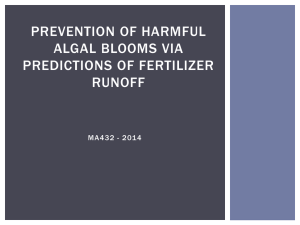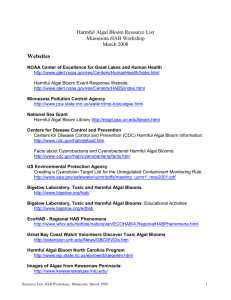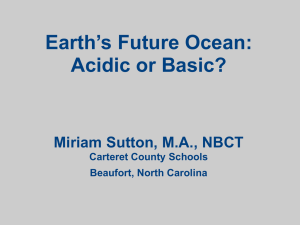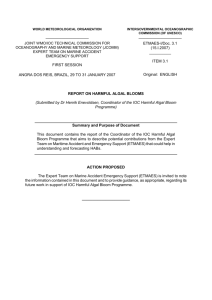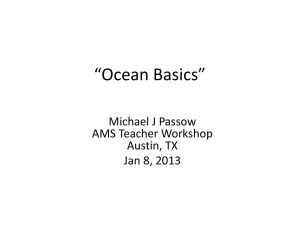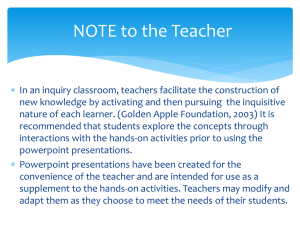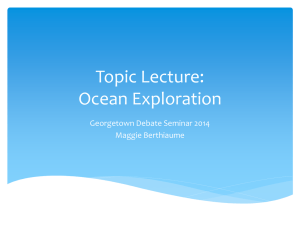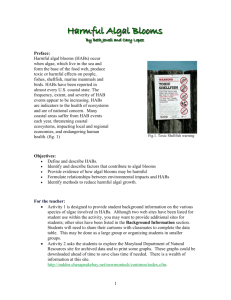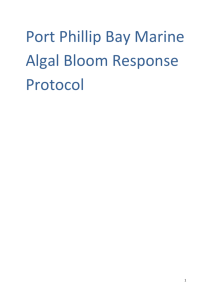NOAA OHHI sessions at APHA - Earth Observing Laboratory
advertisement
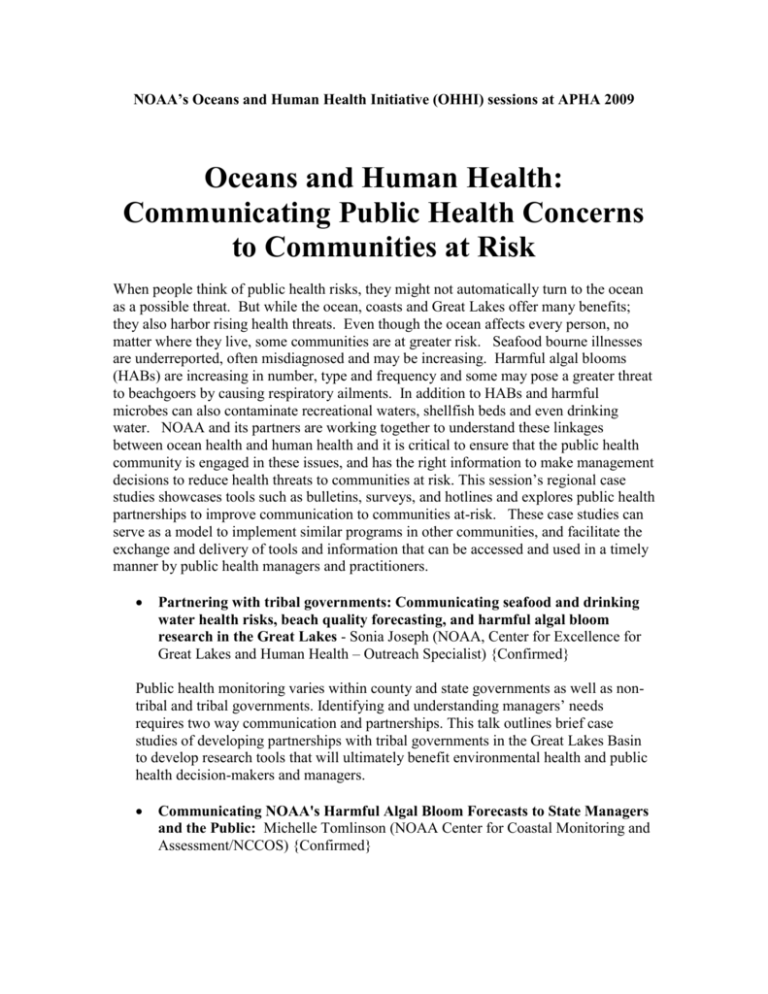
NOAA’s Oceans and Human Health Initiative (OHHI) sessions at APHA 2009
Oceans and Human Health:
Communicating Public Health Concerns
to Communities at Risk
When people think of public health risks, they might not automatically turn to the ocean
as a possible threat. But while the ocean, coasts and Great Lakes offer many benefits;
they also harbor rising health threats. Even though the ocean affects every person, no
matter where they live, some communities are at greater risk. Seafood bourne illnesses
are underreported, often misdiagnosed and may be increasing. Harmful algal blooms
(HABs) are increasing in number, type and frequency and some may pose a greater threat
to beachgoers by causing respiratory ailments. In addition to HABs and harmful
microbes can also contaminate recreational waters, shellfish beds and even drinking
water. NOAA and its partners are working together to understand these linkages
between ocean health and human health and it is critical to ensure that the public health
community is engaged in these issues, and has the right information to make management
decisions to reduce health threats to communities at risk. This session’s regional case
studies showcases tools such as bulletins, surveys, and hotlines and explores public health
partnerships to improve communication to communities at-risk. These case studies can
serve as a model to implement similar programs in other communities, and facilitate the
exchange and delivery of tools and information that can be accessed and used in a timely
manner by public health managers and practitioners.
Partnering with tribal governments: Communicating seafood and drinking
water health risks, beach quality forecasting, and harmful algal bloom
research in the Great Lakes - Sonia Joseph (NOAA, Center for Excellence for
Great Lakes and Human Health – Outreach Specialist) {Confirmed}
Public health monitoring varies within county and state governments as well as nontribal and tribal governments. Identifying and understanding managers’ needs
requires two way communication and partnerships. This talk outlines brief case
studies of developing partnerships with tribal governments in the Great Lakes Basin
to develop research tools that will ultimately benefit environmental health and public
health decision-makers and managers.
Communicating NOAA's Harmful Algal Bloom Forecasts to State Managers
and the Public: Michelle Tomlinson (NOAA Center for Coastal Monitoring and
Assessment/NCCOS) {Confirmed}
NOAA has developed the Harmful Algal Bloom Operational Forecasting System (HABOFS) to alert managers and the general public of the likelihood of impacts due to the
toxic algal species, Karenia brevis, on Florida’s Gulf coast. Detailed information
regarding bloom development, location and extent as well as forecasts of intensification,
extent, transport and impacts are provided to registered users with natural resource
management responsibilities. In addition, a public conditions report is provided on the
HAB-OFS website, to alert beachgoers of the presence of a harmful algal bloom and
likelihood of public health impacts at the coast over the next 3-4 days.
Beach Conditions Report and Marine Toxins Hotline: Dr. Barbara Kirkpatrick
(Mote Marine Laboratory) {Confirmed}
The toxic aerosols from the blooms of Florida red tide, Karenia brevis, cause respiratory
irritation in healthy beachgoers and can trigger reactive airway responses in asthmatics.
Two strategies have been developed and maintained to inform the public about these
toxic aerosols and their human health effects. The Beach Conditions Reporting System
provides near time reports on a variety of conditions important to the beachgoer,
including the presence and/or severity of red tide aerosols. The Marine Toxin hotline
provides callers with pertinent health information regarding the impacts of these aerosols
along with suggested mitigation strategies. Both tools are available 24 hours a day, 365
days a year to the public..
Benefits and Risks of Seafood Consumption: Outreach Education for
Healthcare Providers and Practitioners - Doris T. Hicks (Delaware Sea Grant)
{Confirmed}
The results of a internet survey about consumers understanding of the 2004 FDA/EPA
Advisory about Mercury in Seafood lead a project team to investigate the importance for
the medical community to have access to clear and accurate information about seafood
and its impact on health for at - risk and other patient groups. There is a need to recognize
the range of perspectives for almost any nutritional recommendation and that the more
targeted, informed and balanced the recommendation, the better that advisory will be. An
internet needs assessment survey was developed for healthcare providers to develop a
communication program for the health care community that educates providers about
benefits/risks of seafood consumption, and supplies educational tools for them to share
with their clients and/or patients. Seafood is growing front and center as a healthy food
source worldwide; we want to ensure that the best science-based information is easily
available to health care practitioners and their clients.
Early Warning Bulletin for the Razor Clam Fishery in Washington State –
Dr. Vera Trainer (NOAA Northwest Fisheries Science Center)
Domoic acid-producing Pseudo-nitzchia blooms are a recurrent problem along the entire
Pacific coast of the United States. The toxin, domoic acid, can accumulate in shellfish
and cause amnesic shellfish poisoning (ASP) in human consumers. The Olympic Region
Harmful Algal Bloom (ORHAB) partnership was formed through MERHAB support and
involves Federal, state, and local management agencies, coastal Indian tribes, marine
resource-based businesses, public interest groups, and academic institutions. The
ORHAB partnership ultimately developed and adopted a combination of techniques to
provide managers an effective early warning of domoic acid toxicity in shellfish. The
forecasts generated by ORHAB are now sustained through state funding and have
increased the commercial, subsistence, and recreational harvest of razor clams while
minimizing the health risks to consumers.
Your Oceans and Your Health: Public
Health Surveillance, Prediction,
Prevention and Preparedness
Ocean and coastal related public health risks are on the rise and evolving in unanticipated
ways. From seafood illness to infectious diseases to marine toxins such as harmful algal
blooms (HABs), the oceans and our health are inextricably linked. Our oceans and coasts
are under increasing pressures from coastal development, climate change, and
recreational and commercial use. This session will cover how NOAA and its partners are
working to develop Health Early Warning Systems, integrated public health and marine
disease surveillance, and a One-Health approach to predicting and preventing oceanrelated public health risks. Sessions will cover new approaches that use the ocean as a
predictive tool to get ahead of potential environmental health risks and epidemics that
will ultimately reduce public health threats.
Introduction: Health Early Warning Systems for Ocean, Coasts and Great
Lakes – Juli Trtanj - (NOAA – Oceans and Human Health Initiative Director)
{Confirmed}
This talk will offer a framework for developing Health Early Warning Systems that
integrate public health, marine animal health, ocean and coastal monitoring and
observations, and other key elements to predict health risks. The HEWS goal is to
provide enough lead time to respond to immediate threats, as well as to provide insights
which drive adaptation options at longer time scales, such as social, political, and
institutional changes.
Forecasting Human Health Risks Associated with Oyster Consumption – Dr.
Jay Grimes (University of Southern Mississippi – Microbiologist Faculty)
{Confirmed}
Several species of pathogenic bacteria occur naturally in coastal waters worldwide, some
of which can cause disease outbreaks in humans during specific environmental
conditions. The pathogenic Vibrios are especially problematic and their incidence in
human disease appears to be on the increase. In recent years, remotely sensed (RS) data,
primarily data collected by satellites, have been used to predict the presence of many
different microorganisms including the Vibrios in the ocean. This talk will focus on the
usefulness of RS information to public health practitioners and managers in preventing
human disease caused by the Vibrios, and provide an overview of current, regional ocean
health-public health partnerships.
Harmful Algal Bloom-related Illness Surveillance System (HABISS): A
Multi-State Approach - Dr. Lorraine Backer (CDC) {Confirmed}
In response to the need to support public health decision-making, NCEH has developed a
Harmful Algal Bloom-related Illness Surveillance System (HABISS). HABISS is a
unique surveillance system that includes not only human health data, but also animal
health data and environmental data about the harmful algal blooms (HABs) themselves.
Data collection is organized in modular format that can be expanded to suite the needs of
state and local health and environmental protection agencies. In the future, data collected
and stored in HABISS will be used to assist in predicting local HABs, thus allowing state
public health and environmental health prevention activities to be in place not only in
response to reports of human or animal illnesses, but also in advance of anticipated public
health problems.
Beach Quality Forecasting in the Great Lakes: Using Ocean Observing
Systems to Predict Public Health Issues - Dr. David Rockwell (NOAA Center
of Excellence for Great Lakes and Human Health)
The best current methods for assessing recreational water quality are based on nowcast
models using the concentration of E. coli which requires an incubation for over at least 18
hours. These models reduce occurrences where people unintentionally swim in
contaminated water as well as lost revenues from unnecessary restrictions in swimming.
Contamination by bacteria, viruses and protozoa in recreational waters is a health risk and
having timely accurate forecasts of water quality is critical to protect human health
against adverse exposure situations. The NOAA Center for Great Lakes and Human
Health (CEGLHH) is developing and testing new models incorporating 48-hour forecasts
into beach nowcast models. Recent developments in operational Ocean Observing
Systems (OOS) in the Great Lakes allow parameters such as rainfall, wind direction,
wind velocity and lake currents to be used as explanatory of E. coli levels at the beach.
These models link the parameters that impact water-borne pathogens and provide
swimming safety probabilities so individuals are better informed about contaminated
water risk factors. The goal of the 48-hour forecast model is to provide public health
managers with the likelihood for swimming at modeled beaches. This service will be
relevant because the swimming public can plan where to recreate several days in
advance.
Surveillance for Emerging Diseases: A One Health Approach Incorporating
Marine Mammals Zoonoses – Dr. Teri Rowles (NOAA Marine Mammal Health
and Stranding Response Program)
There is increased recognition that the health of people, animals, and our environment are
inextricably connected and that our historic segmented approach to health sciences needs
change in order to be effective in meeting the health challenges of our changing world.
Human populations have increased interdependence with animals and their products and
natural environments and in many cases share diseases associated with biological
(pathogen), physical, or chemical (biotoxins and persistent organic pollutants) exposures.
This talk will present examples of interdisciplinary wild marine mammal studies that
inform public health and ecosystem health.
